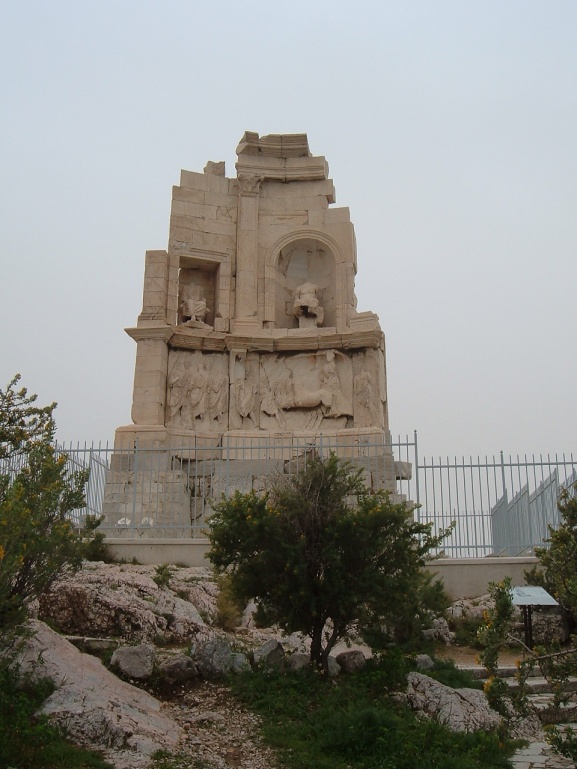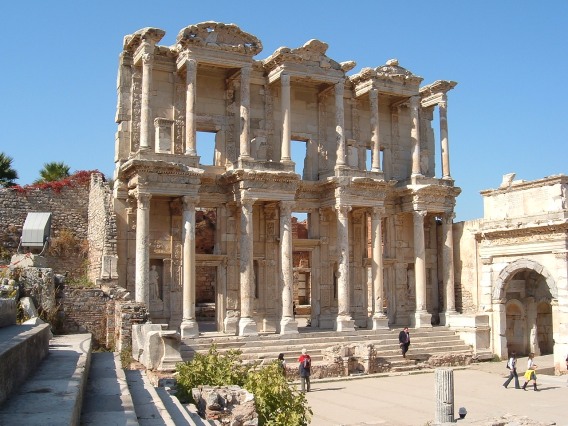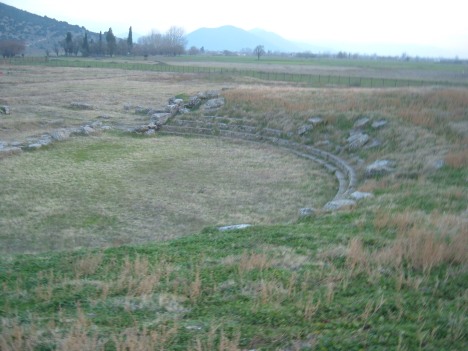One of the most impressive Roman period monuments still to be seen in modern day Athens is the so-called Philopappos monument. This two-storey structure of Pentelic marble – the same local stone that was used to build the Parthenon – was constructed in the early 2nd century AD as a tomb for an eastern prince who had made his home in the city. Gaius Julius Antiochos Epiphanes Philopappos, to give him his full name, is the last known descendent of a dynasty that had ruled the small Hellenistic kingdom of Commagene in what is now southeast Turkey, before it was absorbed into the Roman Empire in the early 1st century AD.

Philoppappos was a member of the upper strata of the Empire’s elite – he rubbed shoulders with the emperors Trajan and Hadrian and even served as consul at Rome. After he settled in Athens he occupied important local magistracies and served as a benefactor to the city. He was also an acquaintance of the great biographer Plutarch, who addressed one of his moralising essays to him. When he died he was granted the honour of a grand public burial on the so-called Mouseion Hill within the city walls, a prominent spot that can be seen from the Acropolis and much of the surrounding area. Today the hill is better known as Philopappou after the man and his monument.
The monument itself, though only partially preserved, is of great interest because enough of the sculptural decoration survives to be able to think about how Philoppappos – or whoever was responsible for the tomb’s design – mixed different elements to project an identity that was at once Greek and Roman, kingly and civic. Perhaps I’ll talk more about the monument itself in a later piece. Here, however, I want to think about this monument as part of a broader phenomenon. There’s quite some evidence that Philopappos was not the only member of the super-elite of the Greeks-speaking eastern half of the Roman Empire to be granted a public tomb at this time.
Anybody who has visited Ephesos in Turkey, or simply seen photos of the site, will be familiar with the now iconic Library of Celsus. Paid for by a Roman Senator of the same generation of Philopappos, the library also served as Celsus’ tomb. Other public burials from around the same time are also attested at Ephesos, which was the capital of the Roman province of Asia (roughly the western part of modern day Turkey) and at several other cities in Asia Minor including Miletos, Aphrodisias and Sagalassos.

In Achaia, the province on which my research focuses (roughly equivalent to southern and central modern day Greece) there is evidence for members of the elite being buried in public spaces at the cities of Messene, Argos, Eretria, Mantinea and Athens. In Athens in addition to the tomb of Philopappos, one of the richest and most prolific of all benefactors, Herodes Atticus, was buried in the stadium that he had bestowed upon the city – the stadium was rebuilt to host the first modern Olympics in 1896 and can still be seen at Athens. His other benefactions included a fountain-house at Olympia, an odeion (small theatre) at Corinth, a major renovation of the stadium at Delphi and the odeion at Athens, which still stands in the city and is used for performances in the annual Athens Festival. Herodes is a fascinating character and I’m sure that I’ll have reason enough to return to him in this blog. Although the stadium where he was interred lay some distance outside the centre of Roman Athens, it was nonetheless a very prominent public space. We also know from a literary source that his daughter was actually buried somewhere in the city centre.
In Greek culture it had always been highly unusual for individuals to be buried in the city centre. There doesn’t usually seem to have been any explicit legal prohibition of intra-urban burial as there was at Rome but for reasons of religion – and no doubt public health as well – the dead were usually buried in cemetery areas just outside the city walls. Exceptions had been made in Archaic through to Hellenistic times for particularly powerful individuals – city founders in new colonies or great generals – but before the Greek world became part of the Roman Empire such intra-urban burials were extremely rare – so rare that the handful of examples I’ve just mentioned as being clustered in the first and second centuries AD represent a marked increase in the practice.
In my last few posts I’ve talked about the ways in which Greek cities in Roman times began to invent tomb monuments, which they claimed belonged to illustrious figures from the historical or – what we would call – the mythological past. Claiming possession of the physical remains of such heroes was a way for cities to compete with one another for prestige and status and for recognition from emperors, such as Hadrian, for whom Classical Greek culture held a deep fascination. I’m exploring this phenomenon in the first part of an article I’m working on. In the second part of the article – which I’ve so far written far less of and hope to finish this week – I am going to consider how these two phenomena – “invented” ancient burials and new burials for the super-elite – might be connected.
There are inscriptions from cities in Asia Minor from this period that describe burial in a public space as the greatest honour that a polis (city) was able to bestow upon its benefactors. In these texts the individuals offered such graves – or their relatives if they were already dead – tended to accept the reward only under protest, presumably because it could be dangerous to seem to have too much status or influence, living under a political system ruled over by an all powerful emperor. But accept they did.
A public tomb was at once both a forceful statement about the wealth, power and status of the deceased and an expression of gratitude on the part of the city for whatever acts of munificence the individual had bestowed upon the community. Public graves were ostentatious and designed to be conspicuous amid the hustle and bustle of daily life. They stood in much frequented civic spaces such as agoras, gymnasia or stadiums. They represent the logical extension of an intricate system of lesser honours which the polis had for centuries – at least since the early Hellenistic period – been bestowing on its wealthy citizens in return for benefactions. Rich elites gave food, festivals and political service and in return received titles, front row seats at festivals, bronze statues. This exchange of gifts and honours was the glue that held the society of these cities together.
The fact that under the Empire Greek cities now began burying their most important benefactors in public tombs in their city centres is a striking phenomenon, which in itself deserves more attention than it has been given in scholarship up to now. One of the things that particularly fascinates me, however, is that this practice was on the increase at precisely the same time that cities seem to have been inventing “ancient” heroic tomb monuments. I don’t believe that can be coincidence.
Last time I discussed the case of Argos, which reading between the lines of Pausanias’ 2nd century AD description, seems to have invented more ancient tomb monuments than any other polis, probably as a way of overcompensating for its relative political insignificance. No archaeological remains of any of the 29 attested grave monuments have been found. Excavations at Argos have, however, discovered three different contemporary Roman period burials – two in the bathhouse and one on the agora, the very area where many of the heroic burials were apparently clustered.
We don’t know much about what the agora tomb itself looked like because not much of the superstructure has been discovered but a human skeleton* was found together with some glass containers, some 120 sheets of gold leaf and a coin in the jaws. If the prominent public location weren’t enough the gold confirms that this was an elite individual. The monument was dated to the mid 2nd Century, so around the time of Pausanias’ visit. So this individual had been laid to rest in the very area where the Titan Prometheus, the hero Danaos and the head of Medusa the Gorgon were believed to be buried. Did any of these mythological connotations rub off on this new tomb?
My project is all about thinking about the way that spatial context contributed to the meaning and perception of public monuments in the Roman period Greek city. If we recognise that these new elite burials were being constructed in the very spaces where great heroes of the distant past were believed to be buried then it looks rather likely that the two types of monuments would have drawn upon each other for meaning. The implication is surely that, by being buried among their most illustrious ancestors the super-benefactors who received this honour were, in some sense thought of in some sense as the equals of these illustrious figures.
Honorific inscriptions in Roman times sometimes do talk of benefactors in heroic terms. Modern scholars have tended to dismiss this as inflated rhetoric and to deny the possibility that these men and women were really thought of as in some way heroic – heroes in Greek thought were semi-divine figures and typically the focus of religious cult. While even the grandest of Roman benefactors probably weren’t thought of as possessing godlike powers I see no reason to doubt that they were at least thought of as closer in nature to the heroes of the past than their fellow mortals.
Elsewhere in Greece there is evidence for certain members of the elite trying to forge specific connections with older tombs believed to belong to their own ancestors. Plutarch, for instance, in his life of Aratos (a great general of the 3rd Century BC) emphasises the prominence of his tomb at Sikyon and the festival that still took place there. The fact that he also dedicates that work to a local family who claimed descent from Sikyon surely hints at the way that these members of the local elite drew prestige from the monument.
Even more striking is the example of the tomb of a man called Podares on the agora of the city of Mantinea. Pausanias describes how this tomb had originally been built for a local general who had died defending the city in the 4th century BC but had been taken over in recent times by one of his descendants who had achieved the Roman citizenship – a sure mark of elite statues in Roman Greece. Remarkably, the late 19th century excavations actually discovered this tomb, identified by roof-tiles marked with an abbreviated form of Podares’ name. Inside they found three tombs. The bodies were missing, probably decayed but the grave goods included writing implements, signs of an educated elite lifestyle, and a gold-leaf crown of the sort cities often bestowed upon benefactors.

This Podares then, and his family, otherwise unknown to us, were clearly important people in Roman Mantinea. Their family tomb monument at the heart of the community advertised their status and did so by explicitly making a connection to the distant historical past. Because the excavations were carried out so long ago there the reports are less complete than we might like but at least one recent scholar has remarked that there is actually little in those reports to confirm that this really was a late Classical monument.** In other words, there is a possibility that Podares’ claim to a distinguished family history and the antiquity of his tomb might have been nothing more than a useful piece of fiction.
There is fairly widespread evidence for members of the Roman period Greek elite claiming descent from famous individuals of the distant past such as Miltiades (the hero of the Battle of Marathon), Perikles (the leading Athenian statesman of the 5th Century BC) and Polybius (the great 2nd C BC historian). I wonder whether members of local elites wishing to advertise particular family connections might not have been a driving influence behind the invention of many of the supposedly ancient tomb monuments in Roman Greece. At the very least, it would have suited the elite class who might hope to see themselves rewarded a public burial to cultivate stories about ancient heroes having tombs within the public spaces of their cities.
To come full circle and to finish with the tomb with which we began it is worth considering what Pausanias has to say about the tomb of Philoppappos at Athens:
“This is a hill right opposite the Acropolis within the old city boundaries, where legend says Musaios used to sing, and, dying of old age, was buried. Afterwards a monument also was erected here to a Syrian.” (Pausanias 1.25.8)
The very fact that Pausanias mentions the two burials in one breath hints at the ways that physical relationships between monuments new and old were important to defining their meaning for the Roman period Greeks. Musaios was a mythical local poet – his name itself is derived from Muse, the name for the Greek female personifications of the arts with whom he was believed to have associated. The 2nd Century AD was a time when advertising their possession of Greek culture, or paideia –including knowledge of history, mythology and rhetoric – became increasingly important for elite self-representation. Could there have been a more appropriate hero for a sophisticated member of the imperial super-elite- particularly one who came from the fringes of the Greek world, as Pausanias’ (perhaps somewhat condescending and geographically wrong) reference to a “Syrian” reminds us – to wish to associate himself with?
It cannot have been a coincidence that Philopappos, or his family, chose the very spot where Musaios was believed to have been buried to set up his tomb. It is not hard to imagine that they might even have breathed new life into this old myth in order to advertise the significance of the new monument. Surely the point that was being made is that Philopappos was, in some sense, to be thought of as a new Musaios – a man who surpassed his fellow citizens in greatness and who was, if not exactly a hero, at least closer to the heroes than most mere mortals were. And that I believe was the point of most of the new public tomb monuments of Roman Greece, something that can only be fully appreciated by thinking about these monuments, as the Greeks would have experienced them, in their spatial context together with the tombs of supposedly ancient heroes.
* The reports of the excavation in the late 1970s, frustratingly say nothing about how much of the skeleton survived or whether it was thought to be male or female but merely mention that the coin was found in the mouth.
** Nino Luraghi (2008b). “Meeting Messenians in Pausanias’ Greece” in Le Péloponnèse D’Épaminondas À Hadrien – Colloque de Tours 6-7 Octobre 2005. C Grandjean, (ed). De Boccard Paris. 191-202.